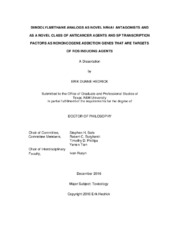| dc.description.abstract | The orphan nuclear receptor 4A1 (NR4A1) and specificity protein (Sp) transcription factors (TFs) are both overexpressed in the majority of solid tumors. Our laboratory has researched the molecular mechanisms of a novel class of 1,1-bis(3'-indolyl)-1-(p-substituted phenyl)methanes (C-DIMs) as NR4A1 antagonists and Sp proteins as non-oncogene addiction genes (NOA) that are targets of reactive oxygen species (ROS) inducing agents. Nr4A1 antagonists (DIM-C-pPhOH) (C-DIM 8) and (DIM-C-pPhCO2Me) (C-DIM 14) inhibited cancer cell proliferation, induced apoptosis, and inhibited migration. The NR4A1 antagonists inhibited constitutive and TGFβ-induced migration in Triple Negative Breast Cancer (TNBC) cells. We also demonstrate that p38α is necessary and sufficient for TGFβ-mediated migration and NR4A1 nuclear export in triple negative breast cancer (TNBC) which was attenuated with NR4A1 antagonists (C-DIMs), leptomycin B, and the p38 inhibitor SB202190. We also demonstrate that NR4A1 is essential for TGFβ-induced EMT and NR4A1 antagonists promoted cytosolic sequestration of the transcription factor β-catenin and its proteasome-dependent degradation in a time dependent manner. β-catenin, along with TCF-3, TCF-4, and LEF-1 binds to TCF/LEF response elements in the NR4A1 promoter, regulating its expression.
RNA interference (RNAi) demonstrates that Sp1, 3, and 4 TFs individually play a role in cancer cell growth, survival and migration/invasion in cancer cell lines. Individual knockdown of Sp1, Sp3, or Sp4, resulted in inhibition of cell growth, migration, and induction of apoptosis, with no compensation. Moreover, tumor growth in athymic nude mice bearing pancreatic cancer xenografts was significantly attenuated in cells depleted of Sp1, Sp3, and Sp4 in combination or Sp1 alone. Ingenuity Pathway Analysis (IPA) of changes in gene expression in Panc1 pancreatic cancer cells after individual knockdown of Sp TFs demonstrates that Sp1-, Sp3- and Sp4-regulated genes were associated with pro-oncogenic activity.
C-DIMs are promising anticancer agents in NR4A1-overexpressing solid tumors and represent a novel class of mechanistic-based drugs that target TGFβ/NR4A1-dependent inducible migration in TNBC. The functional and genomic results coupled with overexpression of Sp transcription factors in tumor vs. non-tumor tissues and decreased Sp1 expression with age indicate that Sp1, Sp3 and Sp4 are non-oncogene addiction (NOA) genes and are attractive drug targets for individual and combined cancer chemotherapies. | en |


